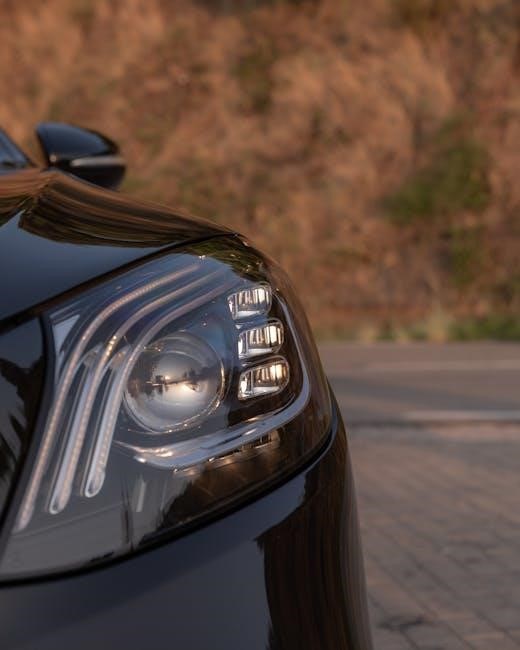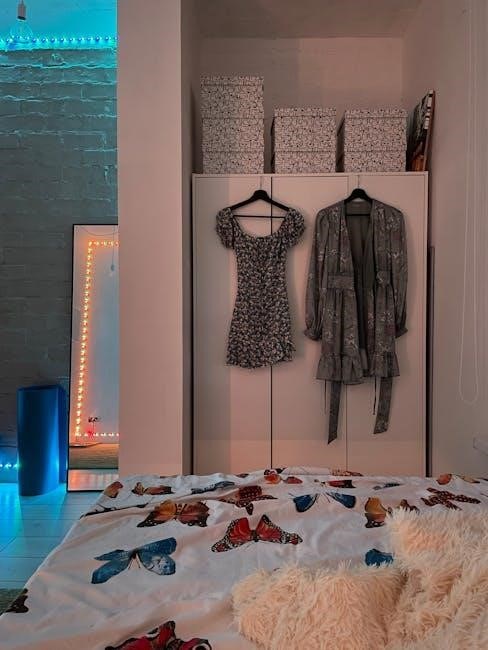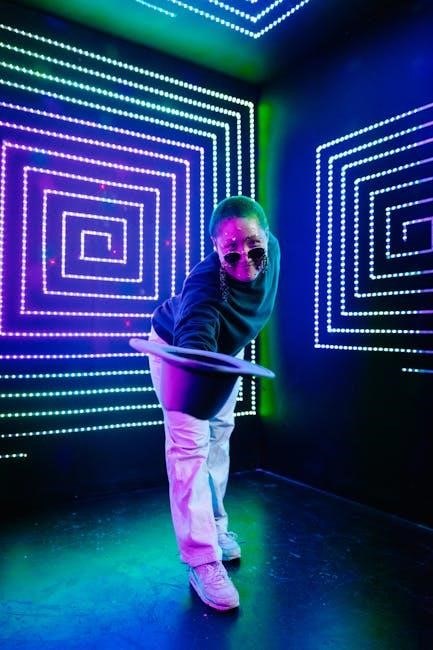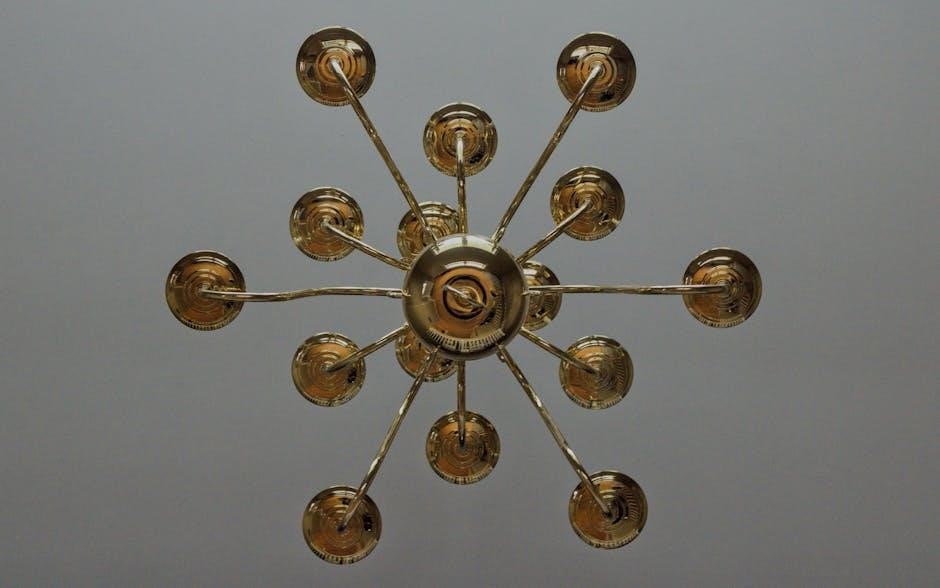Transform your mirror into a stunning LED-lit focal point with this easy, step-by-step guide. Perfect for DIY enthusiasts, it enhances aesthetics and provides ambient lighting solutions.
Discover how to elevate your space with LED strip lighting for mirrors. This guide provides a comprehensive approach to transforming your mirror into a stylish, modern illuminated feature.
Overview of Mirror LED Strip Lighting
Mirror LED strip lighting enhances both functionality and aesthetics, offering bright, energy-efficient illumination. Ideal for vanity, decorative, or mood lighting, these strips are versatile and easy to install. They come in various brightness levels and color temperatures, allowing customization to suit different spaces and preferences, making them perfect for modern home or office setups.

Choosing the Right LED Strip for Your Mirror
Select LED strips based on brightness, color temperature, and size to match your mirror’s style and lighting needs, ensuring a seamless and visually appealing installation.
Brightness and Color Temperature Selection
Brightness and color temperature are crucial for your mirror’s ambiance. For vanity or bathroom mirrors, opt for higher lumens and cooler tones (5000K-6500K) for task lighting. Soft, warm tones (2700K-3000K) create a relaxing mood. Decorative setups may prefer medium brightness with adjustable color temperatures for versatility, ensuring the perfect lighting for any setting. Always consider the room’s style and intended use when selecting.
How to Measure and Cut the LED Strip to Fit Your Mirror
Measure your mirror’s perimeter or frame to determine the required LED strip length. Cut the strip at designated points using scissors or a craft knife. Ensure the cut aligns with the mirror’s edges for a seamless fit. Test the strip’s placement before finalizing. For larger mirrors, divide the strip into sections corresponding to each edge for easier installation and precise alignment.

Materials Needed for Installation
Gather essential materials: LED strip, power supply, adhesive tape, scissors, ruler, and connectors. Ensure all components are compatible for a seamless installation process and optimal results.
Essential Tools and Accessories
Ensure you have the right tools: scissors for cutting the LED strip, a ruler for precise measurements, and a power supply. Accessories like connectors, dimmers, and adhesive strips are crucial. Use a trimmer for excess wiring and a multimeter to check connections. Additionally, touch switches or remote controllers enhance functionality. Always follow manufacturer guidelines for compatibility and safety. These tools and accessories ensure a professional and secure installation.
Adhesive Options for Secure Mounting
For a secure installation, use high-quality adhesives like 3M double-sided tape or silicone-based adhesives. Ensure the mirror surface is clean and dry for optimal bonding. Acrylic adhesives are also effective for long-lasting mounting. Consider the weight and size of the LED strip when selecting adhesive strength. Proper surface preparation is key to prevent peeling or detachment over time. Always test adhesion before final installation to ensure stability.
Preparing Your Mirror for LED Strip Installation
Clean the mirror thoroughly with glass cleaner and a lint-free cloth to remove dirt and streaks. Ensure the surface is dry and free of residue for optimal adhesion.
Cleaning and Readying the Mirror Surface
Begin by thoroughly cleaning the mirror using a glass cleaner and a lint-free cloth to remove dirt, streaks, and residue. For tougher spots, gently scrape with a plastic scraper. Wipe away any old adhesive or adhesive residue using a solvent like isopropyl alcohol. Ensure the surface is completely dry and free of contaminants. Inspect for any cracks or defects that may interfere with LED strip adhesion. Allow the mirror to dry fully before proceeding. Proper preparation ensures secure installation and optimal LED strip performance.

Removing Any Existing Frames or Accessories
Before installing LED strips, assess if your mirror has a frame, clips, or decorative elements. Gently remove any existing frames or accessories using screwdrivers or adhesive removers. For stubborn adhesives, apply heat with a hairdryer to soften the bond. Handle glass and fragile components with care to avoid breakage. Set aside removed parts for reinstallation later. Ensure all surfaces are cleared to allow proper LED strip placement and adhesion.
Installation Methods for Different Mirror Types
For frameless mirrors, adding a border is ideal for LED strip installation. Framed mirrors allow strips to be mounted directly on the frame. Use spacers for frameless mirrors without borders to ensure proper spacing and alignment, enhancing the lighting effect while maintaining a sleek appearance.
Frameless Mirrors: Adding a Border for LED Strips
For frameless mirrors, adding a border is a stylish and functional solution for LED strip installation. Measure the mirror’s edges to determine the border size. Cut the LED strip into equal sections for each side. Peel the backing and press the strips firmly onto the border. Ensure secure adhesion by following manufacturer instructions. This method enhances the mirror’s appearance while providing ambient lighting, creating a modern and elegant look.
Framed Mirrors: Mounting LED Strips on the Frame
For framed mirrors, mount the LED strip directly onto the frame for a seamless look. Measure the frame’s width and cut the LED strip to size. Ensure the frame is clean and dry for proper adhesion. Peel the backing and press the strip firmly along the frame’s edge; Secure any excess wiring behind the frame. This method works well for both flat and ornate frames, blending the lighting into the mirror’s existing design.

Testing and Final Adjustments
Test the LED strip lighting to ensure even illumination and proper function. Adjust brightness and color temperature as needed for optimal results. Verify all connections are secure.
Temporary Installation for Testing
Before permanent installation, temporarily attach the LED strip to your mirror using adhesive clips or tape. Turn on the lights to assess brightness, color, and coverage. This step ensures the lighting meets your expectations and allows for adjustments. Check for any gaps or uneven illumination, making necessary modifications before securing the strip permanently. This method saves time and avoids rework.
Adjusting Brightness and Color Temperature
After installation, fine-tune the LED strip’s brightness and color temperature to achieve your desired ambiance. Use a dimmer or smart controller to adjust brightness levels seamlessly. For color temperature, select from warm white to cool tones based on your preference. Test different settings to ensure the lighting complements your space and provides optimal illumination for tasks like makeup or ambiance creation.

Mounting and Securing the LED Strip
Mount the LED strip securely using strong adhesives or clips. Ensure the surface is clean and dry for optimal adhesion. Align the strip precisely for even illumination.
Best Practices for Adhesion and Positioning
Ensure the mirror surface is clean, dry, and free from dust or oils for optimal adhesion. Peel the backing slowly and press the strip firmly, starting from the center. Align the LED strip precisely along the desired edge or frame, smoothing it out as you go. For frameless mirrors, apply a thin border or use clips to secure the strip. Test the positioning temporarily before final installation.
How to Hide Excess Wiring
Conceal excess wiring by tucking it behind the mirror or frame. Use adhesive cable clips or tape to secure wires along the back or edges. For framed mirrors, route wires inside the frame or behind decorative trim. Apply a cable cover or flexible conduit for a neater look. Ensure all connections are secure and out of sight for a professional finish and safe installation.

Powering and Controlling the LED Strip
Connect the LED strip to a power source, such as a USB port or adapter. Use a dimmer or switch to adjust brightness and color temperature easily.
Connecting to a Power Source
Connect the LED strip to a compatible power source, such as a USB adapter or transformer. Ensure the power source matches the LED strip’s voltage and wattage requirements. Strip the wires at the ends and connect them securely to the power source terminals. Double-check connections to prevent short circuits. Always follow the manufacturer’s instructions for a safe and reliable setup.
Adding a Dimmer or Switch
Install a dimmer or switch to control the LED strip’s brightness and power. Choose between touch sensors, wall-mounted switches, or remote controls for convenience. Connect the dimmer to the power source and LED strip according to the manufacturer’s instructions. Ensure proper wiring to avoid electrical hazards. This addition enhances functionality, allowing you to adjust lighting levels and turn the LEDs on/off seamlessly. Always follow safety guidelines for installation.

Troubleshooting Common Issues
Address flickering by checking connections and power supplies. For uneven lighting, ensure proper installation and inspect for damaged LEDs. Clean the strip and mirror regularly to maintain brightness and functionality.
Fixing Poor Adhesion or Connection Problems
Ensure the mirror surface is clean and dry before reapplying the LED strip. Inspect the adhesive backing for damage and replace if necessary. For loose connections, check the wiring and reattach securely. If the strip detaches easily, consider using additional mounting clips or reinforced adhesive. Test the strip after reinstallation to confirm proper adhesion and functionality.
Addressing Flickering or Uneven Lighting
Check the power source and connections for stability. Ensure the LED strip is properly secured and evenly spaced. If flickering persists, verify dimmer compatibility or switch to a non-dimming power source. Adjust the LED strip’s positioning to achieve uniform brightness. For severe issues, consider replacing the LED strip or consulting a professional to ensure optimal performance and safety.

Maintenance and Care
Regularly clean the LED strip and mirror with a soft cloth to avoid dust buildup. Inspect connections and replace damaged components promptly to ensure optimal performance and longevity.
Cleaning the LED Strip and Mirror
To maintain your LED strip and mirror, use a soft, dry cloth to wipe away dust and dirt. For tougher stains, dampen the cloth with water, but avoid harsh chemicals or abrasive cleaners. Gently scrub the LED strip, ensuring no moisture seeps behind the lights. Dry the surface thoroughly to prevent water spots. Regular cleaning enhances light clarity and keeps your mirror looking pristine for years to come.
Inspecting and Replacing Damaged Components
Regularly inspect your LED strip and mirror for damage, such as flickering lights or cracks. For damaged LEDs, disconnect the power and replace the faulty section with a compatible strip. Ensure all connections are secure and test the lighting afterward. If the mirror is cracked, carefully remove and replace it with a new one, following the same installation steps. This maintains both functionality and aesthetics, preventing further issues.
